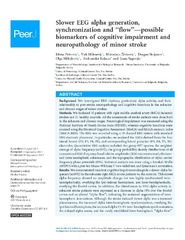Приказ основних података о документу
Slower EEG alpha generation, synchronization and “flow”—possible biomarkers of cognitive impairment and neuropathology of minor stroke
| dc.creator | Petrović, Jelena | |
| dc.creator | Milosevic, Vuk | |
| dc.creator | Živković, Miroslava | |
| dc.creator | Stojanov, Dragan | |
| dc.creator | Milojković, Olga | |
| dc.creator | Kalauzi, Aleksandar | |
| dc.creator | Šaponjić, Jasna | |
| dc.date.accessioned | 2017-11-23T11:27:37Z | |
| dc.date.available | 2017-11-23T11:27:37Z | |
| dc.date.issued | 2017 | |
| dc.identifier.issn | 2167-8359 | |
| dc.identifier.uri | https://peerj.com/articles/3839 | |
| dc.identifier.uri | https://radar.ibiss.bg.ac.rs/handle/123456789/2874 | |
| dc.description.abstract | Background. We investigated EEG rhythms, particularly alpha activity, and their relationship to post-stroke neuropathology and cognitive functions in the subacute and chronic stages of minor strokes. Methods. We included 10 patients with right middle cerebral artery (MCA) ischemic strokes a nd 11 healthy controls. All the assessments of stroke patients were done both in the subacute and chronic stages. Neurological impairment was measured using the National Institute of Health Stroke Scale (NIHSS), whereas cognitive functions were assessed using the Montreal Cognitive Assessment (MoCA) and MoCA memory index (MoCA-MIS). The EEG was recorded using a 19 channel EEG system with standard EEG electrode placement. In particular, we analyzed the EEGs derived from the four lateral frontal (F3, F7, F4, F8), and corresponding lateral posterior (P3, P4, T5, T6) electrodes. Quantitative EEG analysis included: the group FFT spectra, the weighted average of alpha frequency (α AVG), the group probability density distributions of all conventional EEG frequency band relative amplitudes (EEG microstructure), the inter- and intra-hemispheric coherences, and the topographic distribution of alpha carrier frequency phase potentials (PPs). Statistical analysis was done using a Kruskal-Wallis ANOVA with a post-hoc Mann-WhitneyU two-tailed test, and Spearman's correlation. Results. We demonstrated transient cognitive impairment alongside a slower alpha fre- quency (αAVG) in the subacute right MCA stroke patients vs. the controls. This slower alpha frequency showed no amplitude change, but was highly synchronized intra- hemispherically, overlying the ipsi-lesional hemisphere, and inter-hemispherically, overlying the frontal cortex. In addition, the disturbances in EEG alpha activity in subacute stroke patients were expressed as a decrease in alpha PPs over the frontal cortex and an altered "alpha flow", indicating the sustained augmentation of inter- hemispheric interactions. Although the stroke induced slower alpha was a transient phenomenon, the increased alpha intra-hemispheric synchronization, overlying the ipsi-lesional hemisphere, the increased alpha F3-F4 inter-hemispheric synchronization, the delayed alpha waves, and the newly established inter-hemispheric "alpha flow" within the frontal cortex, remained as a permanent consequence of the minor stroke. This newly established frontal inter-hemispheric "alpha flow" represented a permanent consequence of the ``hidden" stroke neuropathology, despite the fact that cognitive impairment has been returned to the control values. All the detected permanent changes at the EEG level with no cognitive impairment after a minor stroke could be a way for the brain to compensate for the lesion and restore the lost function. Discussion. Our study indicates slower EEG alpha generation, synchronization and ``flow" as potential biomarkers of cognitive impairment onset and/or compensatory post-stroke re-organizational processes. | en |
| dc.rights | openAccess | |
| dc.rights.uri | https://creativecommons.org/licenses/by/4.0/ | |
| dc.source | PeerJ | |
| dc.subject | Alpha activity | |
| dc.subject | Biomarkers | |
| dc.subject | Cognitive impairment | |
| dc.subject | Electroencephalography | |
| dc.subject | Stroke | |
| dc.title | Slower EEG alpha generation, synchronization and “flow”—possible biomarkers of cognitive impairment and neuropathology of minor stroke | en |
| dc.type | article | |
| dc.rights.license | BY | |
| dcterms.abstract | Милојковић, Олга; Живковић, Мирослава; Милосевиц, Вук; Петровић, Јелена; Шапоњић, Јасна; Стојанов, Драган; Калаузи, Aлександар; | |
| dc.rights.holder | © 2017 Petrovic et al. | |
| dc.citation.issue | 9 | |
| dc.citation.volume | 5 | |
| dc.identifier.doi | 10.7717/peerj.3839 | |
| dc.identifier.pmid | 28970969 | |
| dc.identifier.scopus | 2-s2.0-85030238700 | |
| dc.identifier.wos | 000411967800002 | |
| dc.citation.apa | Petrovic, J., Milosevic, V., Zivkovic, M., Stojanov, D., Milojkovic, O., Kalauzi, A., & Saponjic, J. (2017). Slower EEG alpha generation, synchronization and “flow”—possible biomarkers of cognitive impairment and neuropathology of minor stroke. PeerJ, 5(9), e3839. | |
| dc.citation.vancouver | Petrovic J, Milosevic V, Zivkovic M, Stojanov D, Milojkovic O, Kalauzi A, Saponjic J. Slower EEG alpha generation, synchronization and “flow”—possible biomarkers of cognitive impairment and neuropathology of minor stroke. PeerJ. 2017;5(9):e3839. | |
| dc.citation.spage | e3839 | |
| dc.citation.epage | e3839 | |
| dc.type.version | publishedVersion | en |
| dc.identifier.fulltext | https://radar.ibiss.bg.ac.rs//bitstream/id/3273/PeerJ_2017_5_9_e3839.pdf | |
| dc.citation.rank | M21 |

